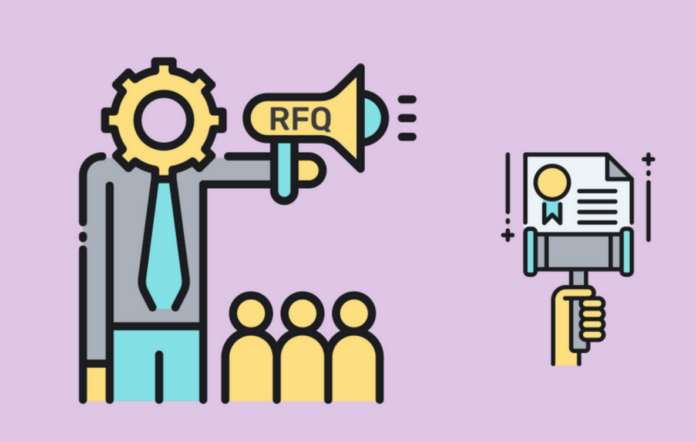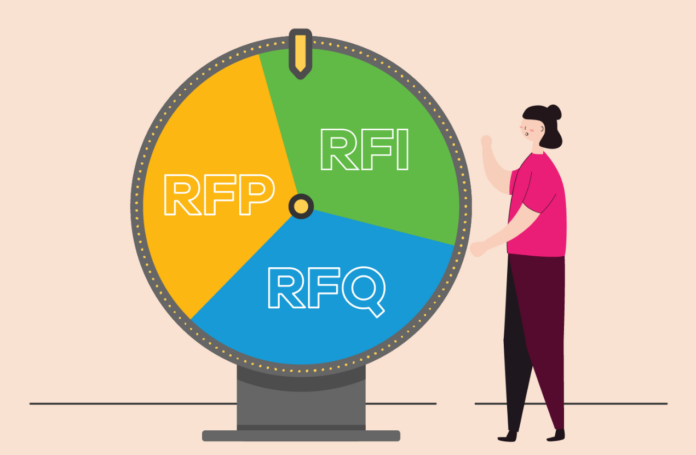Deciding between RFI, RFP, and RFQ requests in your procurement process can be crucial to its success. Each tool serves a distinct function and can have an enormous impact on how successful your sourcing activities will be.
Understanding their unique purposes, strengths, and ideal contexts of use is key to ensuring you select the most effective method for your organizational needs and ultimately lead to a successful procurement process.
After reading today’s post, check out Bridgit’s article: RFI vs RFP vs RFQ: what’s the difference?
Understanding the purpose of RFI, RFP, and RFQ
Let’s explore the distinctions between RFI, RFP, and RFQ and how these differences help shape unique procurement scenarios and direct the decision-making process.
Request for information (RFI)

An RFI is used when you need to gather information about the capabilities of various suppliers. It’s often used early in the procurement process when you’re trying to narrow down your list of potential suppliers. The RFI:
- Provides an overview of available options in the market
- Helps in understanding the capabilities of various suppliers
- Serves as a tool for preliminary decision-making
Request for proposal (RFP)
The RFP is a more detailed document used when you have identified your requirements and are ready to invite suppliers to propose how they can meet your needs. The RFP:
- Sets out specific requirements for the product or service
- Facilitates a competitive bidding process
- Evaluates potential suppliers based on predefined criteria
Request for quotation (RFQ)
The RFQ is used when you know exactly what you need, down to the specifications and quantities, and are simply looking for the best price. The RFQ:
- Specifies detailed requirements
- Compares suppliers based on price and delivery timelines
- Is often used for repeat orders or standard items
Strengths and limitations – when to use each tool
To maximize the power of RFI, RFP, and RFQ in your procurement process, it is vital that you fully comprehend each tool’s strengths and limitations, as well as the optimal usage scenarios for each one.
RFI Strengths and Limitations

Strengths:
- An RFI (Request for Information) is excellent for conducting broad market research. It allows you to cast a wide net to understand what potential suppliers are out there and what they offer.
- It significantly reduces risk by identifying potential suppliers early in the procurement process. This early engagement can help in shortlisting suitable suppliers for future, more specific inquiries.
- Facilitates informed decision-making by gathering comprehensive information about suppliers’ capabilities, experience, and resources, which is crucial in the initial planning stages.
Limitations:
- An RFI may result in an overwhelming amount of information, which can be time-consuming to sift through and analyze effectively.
- It doesn’t guarantee a comprehensive analysis of all potential suppliers, as not all may respond, and responses might vary significantly in quality and detail.
- RFIs typically lack specificity regarding product or service requirements, focusing more on general capabilities than specific offerings.
When to use:
An RFI is most useful in the early stages of a procurement process. It’s ideal when your organization needs a broad understanding of the market and potential suppliers’ capabilities, without yet having detailed, specific requirements for products or services.
RFP Strengths and Limitations
Strengths:
- RFPs (Request for Proposals) enable detailed comparisons between suppliers. They provide a structured format for suppliers to submit their solutions, making it easier to compare them on an apples-to-apples basis.
- They facilitate competitive bidding, which can lead to better pricing, quality, and terms. The competitive nature of RFPs often drives suppliers to offer their best solutions.
- Allows suppliers to propose creative, tailor-made solutions. This can be particularly advantageous when the procurement needs are unique or require innovative approaches.
Limitations:
- Creating and responding to an RFP can be very time-consuming. It requires a significant investment of time and resources from both the organization and the suppliers.
- RFPs demand a clear, detailed understanding of the organization’s needs and requirements, which can be a challenge to articulate accurately.
When to Use:
- An RFP is most effective when you have clear, specific requirements but are looking for varied solutions to those needs. It’s particularly useful when you want suppliers to provide customized solutions or innovative approaches to meet your organization’s unique requirements.
RFQ Strengths and Limitations

Strengths:
- RFQs (Request for Quotations) provide precise, easily comparable quotes. They are straightforward and focused, mainly on price and delivery terms.
- Ideal for streamlining the purchasing process, especially for standard, off-the-shelf items where the specifications are already well-defined and agreed upon.
- Often results in faster procurement cycles, as it cuts down on negotiation time and simplifies the decision-making process.
Limitations:
- Not suitable for complex or bespoke requirements, as RFQs focus solely on price and basic service delivery parameters.
- They do not encourage suppliers to propose innovative or creative solutions. This can be a significant drawback when the procurement needs involve solving complex challenges or require out-of-the-box thinking.
When to use:
Use an RFP when you have clear requirements yet are open to finding different solutions to meet them. An RFP allows you to customize a solution exactly to meet your individual needs.
RFQ strengths and limitations
Strengths
- Provides precise, easily comparable quotes
- Streamlines purchasing of standard items
- Often results in faster procurement cycles
Limitations
- Not suitable for complex requirements, as it focuses solely on price and delivery
- Does not encourage suppliers to propose innovative solutions
When to use:
Use an RFQ when you know exactly what you want with your financial objectives, down to the detailed specifications, and you’re looking to compare potential suppliers based purely on price and delivery terms. An RFQ is ideal for repeat orders or standard items.
RFI, RFP, and RFQ – final thoughts

In conclusion, the decision between employing an RFI, RFP, or RFQ in your procurement process hinges on your sourcing activity’s specific needs and stage.
An RFI is perfect for the initial stages, allowing for comprehensive market research and an understanding of supplier capabilities.
An RFP — on the other hand — is ideal when the requirements are clear, but you’re open to various approaches to meet those needs, encouraging suppliers to propose customized solutions.
Lastly, an RFQ is best suited when precise specifications are known, and the core comparison metrics are price and delivery terms.
Effectively utilizing these tools based on your procurement needs can streamline the sourcing process, reduce risk, and lead to better decision-making.
Understanding the strengths and limitations of each can help ensure their optimal use, ultimately supporting a successful procurement process.








